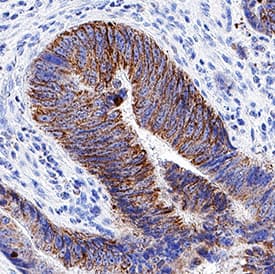Recombinant Mouse TLR1 Protein, CF Summary
Product Specifications
Ser25-Asp581, with a C-terminal 10-His tag
Analysis
Customers also Viewed
Product Datasheets
Carrier Free
CF stands for Carrier Free (CF). We typically add Bovine Serum Albumin (BSA) as a carrier protein to our recombinant proteins. Adding a carrier protein enhances protein stability, increases shelf-life, and allows the recombinant protein to be stored at a more dilute concentration. The carrier free version does not contain BSA.
In general, we advise purchasing the recombinant protein with BSA for use in cell or tissue culture, or as an ELISA standard. In contrast, the carrier free protein is recommended for applications, in which the presence of BSA could interfere.
1476-TR
| Formulation | Lyophilized from a 0.2 μm filtered solution in PBS. |
| Reconstitution | Reconstitute at 100 μg/mL in sterile PBS. |
| Shipping | The product is shipped at ambient temperature. Upon receipt, store it immediately at the temperature recommended below. |
| Stability & Storage: | Use a manual defrost freezer and avoid repeated freeze-thaw cycles.
|
Background: TLR1
The Toll-like family of molecules are type I transmembrane proteins that serve as pattern recognition receptors for microbial pathogens. There are at least twelve mouse and ten human TLRs that activate the innate immune system following exposure to a variety of microbial species (1, 2). TLRs contain a large number of leucine-rich repeats (LRRs) and a cytoplasmic tail with one Toll/IL-1 receptor (TIR) domain. Mature mouse TLR1 consists of a 557 amino acid (aa) extracellular domain (ECD) with 20 LRRs, a 21 aa transmembrane segment, and a 192 aa cytoplasmic domain (3, 4). Within the ECD, mouse TLR1 shares 60% aa sequence identity with mouse TLR6 and 19% -27% aa sequence identitity with mouse TLR2, -3, -4, -5, -7, -8, -9, -11, -12, and -13. It shares 73% and 86% aa sequence identity with human and rat TLR1, respectively. TLR1 is expressed on the surface of macrophages, dendritic cells, and tonsillar epithelial cells in ligand-independent association with TLR2 (5 - 8). TLR2 additionally associates with TLR6 to form a functional complex with specificity for distinct but related microbial ligands (9 - 11). TLR1 and TLR2 cooperate in the recognition of bacterial and protozoal triacylated lipopeptides and glycosylphosphatidylinositols (6, 10 - 12). Ligand binding induces TLR1 localization to lipid rafts followed by receptor internalization and activation of NF kappa B (7, 11, 13).
- Miyake, K. (2007) Semin. Immunol. 19:3.
- Hopkins, P.A. and S. Sriskandan (2005) Clin. Exp. Immunol. 140:395.
- SwissProt # Q9EPQ1.
- Matsushima, N. et al. (2007) BMC Genomics 8:124.
- Ochoa, M.-T. et al. (2003) Immunology 108:10.
- Takeuchi, O. et al. (2002) J. Immunol. 169:10.
- Triantafilou, M. et al. (2006) J. Biol. Chem. 281:31002.
- Sandor, F. et al. (2003) J. Cell Biol. 162:1099.
- Nakao, Y. et al. (2005) J. Immunol. 174:1566.
- Ozinsky, A. et al. (2000) Proc. Natl. Acad. Sci. 97:13766.
- Lee, J.Y. et al. (2004) J. Biol. Chem. 279:16971.
- Krishnegowda, G. et al. (2005) J. Biol. Chem. 280:8606.
- Nishiya, T. and A.L. DeFranco (2004) J. Biol. Chem. 279:19008.
FAQs
No product specific FAQs exist for this product, however you may
View all Proteins and Enzyme FAQsReconstitution Buffers
Reviews for Recombinant Mouse TLR1 Protein, CF
There are currently no reviews for this product. Be the first to review Recombinant Mouse TLR1 Protein, CF and earn rewards!
Have you used Recombinant Mouse TLR1 Protein, CF?
Submit a review and receive an Amazon gift card.
$25/€18/£15/$25CAN/¥75 Yuan/¥2500 Yen for a review with an image
$10/€7/£6/$10 CAD/¥70 Yuan/¥1110 Yen for a review without an image











